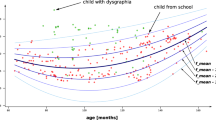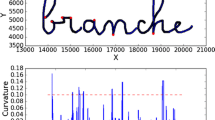Abstract
Polygonal shape drawing tasks are commonly used in psychological, clinical and standard handwriting tests to evaluate children’s development. Early detection of physical/mental disorders within subjects therefore requires objective analysis of the drawing tasks. This analysis would help to identify specific rehabilitation needs and accurate detection of disorders. Herein, the aim is to determine the correlation between the performance of polygonal shape drawing and levels in handwriting performance. In the reported experimentation two groups of participants aged between 6 and 7 were studied. The first group was identified by educational experts as being below-average writers within their age group whilst the second group was age-matched controls of average and above. Subjects were required to draw an isosceles triangle within a novel computer-based framework founded on a pen-based graphic tablet capture device. Subsequently, a sequential feature vector containing performance values relating to the order in which they drew the triangle was extracted from tablet data and compared against one another when presented in constructional strategy models. Statistical analyses and automated classification were applied to sequences to infer handwriting level based on the triangle drawing strategy. From our experiments drawing strategies showed significant differences in drawing end-point position, number of strokes used, and the frequency of particular drawing strategies amongst average and below-average handwriting groups. Additionally, a support vector machine classifier was used to detect group membership based on the triangle drawing strategy. From this exemplar polygonal shape drawing study it is revealed that there are details in children’s drawing strategy which considerably differs in grouping based on handwriting performance.






Similar content being viewed by others
References
Medwell J, Wray D (2008) Handwriting—a forgotten language skill. Lang Educ 22(1):34–47. doi:10.2167/le722.0
Iverson JM, Braddock BA (2011) Gesture and motor skill in relation to language in children with language impairment. J Speech Lang Hear Res 54(1):72–86. doi:10.1044/1092-4388(2010/08-0197
Connelly V, Dockrell JE, Barnett A (2011) Children challenged by writing due to language and motor difficulties. In: Berninger V (ed) Cognitive psychology of writing handbook: past, present, and future contributions of cognitive writing research to cognitive psychology. Psychology Press, New York
Sudirman R, Tabatabaey-Mashadi N, Ariffin I (2011) Aspects of a standardized automated system for screening children’s handwriting. In: 1st international conference on informatics and computational intelligence, Bandung, pp 49–54. doi:10.1109/ICI.2011.19
Fairhurst MC, Linnell T, Glenat S, Guest RM, Heutte L, Paquet T (2008) Developing a generic approach to online automated analysis of writing and drawing tests in clinical patient profiling. Behav Res Methods 40(1):290–303. doi:10.3758/brm.40.1.290
Richardson A, Kraus S, Weiss PL, Rosenblum S (2008) COACH—cumulative online algorithm for classification of handwriting deficiencies. In: 23rd AAAI conference and the 20th innovative applications of artificial intelligence conference, AAAI-08/IAAI-08, Chicago, pp 1725–1730
Rosenblum S, Dvorkin AY, Weiss PL (2006) Automatic segmentation as a tool for examining the handwriting process of children with dysgraphic and proficient handwriting. Hum Mov Sci 25(4–5):608–621. doi:10.1016/j.humov.2006.07.005
Vinter A, Marot V (2007) The development of context sensitivity in children’s graphic copying strategies. Dev Psychol 43(1):94–110
Braswell GS, Rosengren KS, Pierroutsakos SL (2007) Task constraints on preschool children’s grip configurations during drawing. Dev Psychobiol 49(2):216–225
Vaid J (1995) Script directionality influences nonlinguistic performance: evidence from Hindi and Urdu. In: Olson ITD (ed) Scripts and literacy: reading and learning to read alphabets, syllabaries and characters. Kluwer Academic Publishers, Dordrecht, pp 295–310
Taguchi M, Noma Y (2005) Relationship between directionality and orientation in drawings by young children and adults. Percept Mot Skills 101(1):90–94. doi:10.2466/pms.101.1.90-94
Nachshon I, Alek M (1981) The development of directional preferences: cross-cultural differences. Psychologia 24:86–96
Taguchi M (2010) Cultural differences in drawing movements between right-handed japanese and german participants. Psychol Rep 107(1):329–335. doi:10.2466/10.23.25.pr0.107.4.329-335
Picard D (2009) Impact of manual preference on directionality in children’s drawings. Laterality: Asymmetries Body Brain Cognit 16(1):24–34. doi:10.1080/13576500903140610
Mirvaziri H, Javidi MM, Mansouri N (2009) Handwriting recognition algorithm in different languages: survey. In: Proceedings of the 1st international visual informatics conference on visual informatics: bridging research and practice, Kuala Lumpur. Springer, New York, pp 487-497. doi:10.1007/978-3-642-05036-7_46
Li X, Srimathveeravalli G, Singla P, Kesavadas T (2009) A novel and robust algorithm to model handwriting skill for haptic applications. In: IEEE international conference on systems, man and cybernetics, pp 2912–2917
Kocherry JJ, Srimathveeravalli G, Chowriappa AJ, Kesavadas T, Gwanseob S (2009) Improving haptic experience through biomechanical measurements. In: Third joint EuroHaptics conference and symposium on haptic interfaces for virtual environment and teleoperator systems, pp 362–367
Chowriappa A, Subrahmaniyan N, Srimathveeravalli G, Bisantz A, Kesavadas T (2009) Modeling and defining expert handwriting behavior. In: IEEE international conference on systems, man and cybernetics, pp 2918–2923
Liang Y, Guest R, Fairhurst M, Potter J (2007) Feature-based assessment of visuo-spatial neglect patients using hand-drawing tasks. Pattern Anal Appl 10(4):361–374. doi:10.1007/s10044-007-0074-x
deDiego-Cottinelli A, Barros B (2010) TRAZO: a tool to acquire handwriting skills using Tablet-PC devices. In: 9th international conference on interaction design and children, Barcelona. ACM, pp 278–281. doi:10.1145/1810543.1810591
Rosenblum S, Weiss T (2011) Tele-evaluation for the handwriting performance. Educ Psychol Rev 15(1):41–81. http://research.haifa.ac.il/~rosens/ResearchDescriptionBlurb.pdf; http://www.webcitation.org/6350Tjv98
Khalid PI, Yunus J, Adnan R, Harun M, Sudirman R, Mahmood NH (2010) The use of graphic rules in grade one to help identify children at risk of handwriting difficulties. Res Dev Disabil 31(6):1685–1693. doi:10.1016/j.ridd.2010.04.005
Khalid PI, Yunus J, Adnan R (2010) Extraction of dynamic features from hand drawn data for the identification of children with handwriting difficulty. Res Dev Disabil 31(1):256–262. doi:10.1016/j.ridd.2009.09.009
Gillespie HM (2003) Component handwriting skills among early elementary children with average and below average printing ability. Northwestern University, Evanston
Thibaut J-P, Toussaint L (2010) Developing motor planning over ages. J Exp Child Psychol 105(1–2):116–129. doi:10.1016/j.jecp.2009.10.003
Picard D, Vinter A (2005) Development of graphic formulas for the depiction of familiar objects. Int J Behav Dev 29(5):418–432. doi:10.1080/01650250500206117
Sarfraz M (2005) Computer-aided intelligent recognition techniques and applications. Wiley, West Sussex
Simner ML, Leedham CG, Thomassen AJWM (1996) Handwriting and drawing research: basic and applied issues. IOS press, Amsterdam
Goldstein G, Beers SR, Hersen M (2004) Comprehensive handbook of psychological assessment: intellectual and neuropsychological assessment, vol 1. Wiley, New Jersey
Rémi C, Frélicot C, Courtellemont P (2002) Automatic analysis of the structuring of children’s drawings and writing. Pattern Recognit 35(5):1059–1069. doi:10.1016/S0031-3203(01)00094-2
Child-Development-Network (2003) Child development milestones—5 years. Queensland Government, Queensland Health
Olsen JZ (2009) Handwriting standards kindergarten through grade four. Handwrit Without Tears. http://www.hwtears.com/files/Standards%20k-4_FINAL.pdf; http://www.webcitation.org/6TifLPt8t
Beery KE, Buktenica NA, Beery NA (2004) Beery-Buktenica developmental test of visual-motor integration, 5th edn. Pearson Assessment Inc., San Antonio
Rubin M (2011) Fine motor skills and first grade readiness. http://www.connectionsmag.co.il/articlenav.php?id=1170; http://www.webcitation.org/634y6DVFt. Accessed 2011
Rosenblum S (2008) Development, reliability, and validity of the Handwriting Proficiency Screening Questionnaire (HPSQ). Am J Occup Ther 62(3):298–307
Cobbah WGK, Guest RM (1998) Graphics Tablet Data Capture Program, 1.2 edn. University of Kent Electronic Engineering Labs Kent, UK
Klema J, Novakova L, Karel F, Stepankova O, Zelezny F (2008) Sequential data mining: a comparative case study in development of atherosclerosis risk factors. IEEE Trans Syst Man Cybern Part C Appl Rev 38(1):3–15
Burges CJC (1998) A tutorial on support vector machines for pattern recognition. Data Min Knowl Discov 2(2):121–167
Kecman V (2001) Learning and soft computing. The MIT Press, Cambridge
Vapnik V (1982) Estimation of dependences based on empirical data (1972 in Russian, Nauka, Moscow) English translation. Springer, New York
Cortes C, Vapnik V (1995) Support vector network. Mach Learn 20:1–25
Hsu C-W, Chang C-C, Lin C-J (2010) A practical guide to support vector classification. Department of Computer Science, National Taiwan University, Taipei, Taiwan
Chang C-C, Lin C-J (2001) LIBSVM: a library for support vector machines. ACM Trans Intelligent Sys Technol 2(3):27. http://www.csie.ntu.edu.tw/~cjlin/libsvm/
Goodnow JJ, Levine RA (1973) “The grammar of action”: sequence and syntax in children’s copying. Cogn Psychol 4(1):82–98. doi:10.1016/0010-0285(73)90005-4
Tucha O, Lange KW (2005) The effect of conscious control on handwriting in children with attention deficit hyperactivity disorder. J Atten Disord 9(1):323–332. doi:10.1177/1087054705279994
Binder C, Haughton E, Bateman B (2002) Fluency: achieving true mastery in the learning process. Professional Papers in special education, 2–20
Stone CA, Siliman ER, Ehren BJ, Apel K (eds) (2005) Handbook of language and literacy: development and disorders. The Guilford Press, New York
Feder KP, Majnemer A (2007) Handwriting development, competency, and intervention. Dev Med Child Neurol 49(4):312–317. doi:10.1111/j.1469-8749.2007.00312.x
Koppenhaver K (2007) Forensic document examination: principles and practice. Humana Press, USA
Alston J, Taylor J (1987) Handwriting: theory, research and practice. Croom Helm, BR31AT England
Heath R, Rouhana A, Abi Ghanem D (2005) Asymmetric bias in perception of facial affect among roman and Arabic script readers. Laterality 10(1):51–64. doi:10.1080/13576500342000293
Fagard J, Dahmen R (2003) The effects of reading–writing direction on the asymmetry of space perception and directional tendencies: a comparison between French and Tunisian children. Laterality 8(1):39–52
Acknowledgments
The authors like to thank the Malaysia Ministry of Higher Education and Universiti Teknologi Malaysia for funding the study under Vote Q.J130000.7123.00J07.
Author information
Authors and Affiliations
Corresponding author
Rights and permissions
About this article
Cite this article
Tabatabaey-Mashadi, N., Sudirman, R., Guest, R.M. et al. Analyses of pupils’ polygonal shape drawing strategy with respect to handwriting performance. Pattern Anal Applic 18, 571–586 (2015). https://doi.org/10.1007/s10044-014-0423-5
Received:
Accepted:
Published:
Issue Date:
DOI: https://doi.org/10.1007/s10044-014-0423-5




